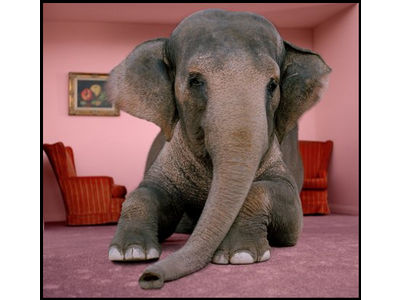The Elephant in the Room
Up Next
One Bite At A Time
Image courtesy of suecroftphysiotherapistblog.wordpress.com
Today’s guest post is by coach, author, and radio host Bill Patton. His latest book, How to End Cheating in Junior Tennis, is available online at this link: www.Amazon.com. Enjoy!
“It’s alarming to note that 38% of junior tennis players play only one tournament prior to dropping out of tournament play. We need to do all we can together to create a fair tournament experience as the main feature to help encourage our new competitors to continue to excel in our sport.” Bill Mountford, USTA
Our tennis family is in trouble. We need family therapy, and now it is time to talk about the elephant in the front room, that some have been ignoring. Others have pretended that the elephant is not such a big problem, or that they really don’t mind elephants, or even that having an elephant in the front room develops character. Life has prepared me to discuss these things, and I never would have thought that growing up in a fairly dysfunctional family would ever be a strength, but it seems so now. The elephant in the front room of junior tennis is cheating and other forms of gamesmanship and intimidation. At the recent Tennis Summit, one seminal moment was the panel discussion led by Kurt Kamperman of the USTA, that included Dan Santorum (PTR), John Embree (USPTA) and Paul Lubbers (USTA), when all agreed that cheating in juniors has reached an epidemic proportion, and that it is a key factor in causing players to leave the sport. The proportion of the problem is elephant sized.
Mark Tennant who plays a key role in educating Tennis Coaches in the U.K. believes it’s more so a problem in the U.S. than it is internationally largely because coach and parenting education in most countries addresses this problem. So, let’s begin to educate ourselves in regard to the problem which we now face.
Perhaps you have heard the question “How do you eat an elephant?” and the answer “One bite at a time”. How true for the situation in which we find ourselves. Of course one person eating alone will not reduce the size very quickly. Lets assume that hundreds if not thousands of tennis stakeholders are reading this, if each one were to get out their spoon, we all working together can quickly begin to reduce the size of the problem. It takes some courage to take that first bite. If a very large cross section of parents and coaches were to make a commitment to working the problem we can make an enormous impact.
We need to understand what is a complex problem, because we can’t take a scorched earth approach to dealing with it. I have run many tournaments, sanctioned by various organizations, and also my own private events. Over the course of my 27 year career I have observed these approximate statistics: 80% of the bad calls I have seen are simply because making calls is a difficult task, 15% of bad calls come as a result of a player wanting to win so badly, that they become psychologically blinded, and they sincerely believe or want to believe their bad call. Having that trait may be key indicator for future success, but not if used as an excuse to make mistakes in fairness. Finally, ‘criminal’ bad calls comprise about 5%, 1 in 20, because in the mind of the player “It’s break point and the ball is on the line, so I will call it out to speed things along for me. I can win a little easier, and save some energy. Besides all the other kids are doing it.” Much of that thinking which plays out subconsciously, but in the minds of some, it is a conscious decision. That behavior must be addressed.
Whether or not a player makes a mistake, faces pressure to win and sees wrongly, or faces intense pressure from parents or coaches to win all these players can be helped. The appalling thing is that I know of so-called ‘tennis academies’ that seem to have a high percentage of players who make bad calls, have parents sending signals from the sideline, and use different forms of gamesmanship such as trying to confuse the score, or trying to intimidate and annoy the opponent. Academy suggests an educational component, so I would say those academies are teaching ‘how to ruin the sport’.
“No problem can be solved from the same level of consciousness that created it.” Albert Einstein
The Cat, The Tree and the Snake
Three blind men approached an elephant. One touched its tale and said, “It’s a cat.” Another felt the rough skin on the leg and said, “It’s a tree,” and the other its trunk and exclaimed, “It’s a snake.”
Consider the entire problem first. It’s very easy to see the problem through the lens of our own experience. What we can do together is understand a global solution and get to work on the larger parts of the problem. The coaches may say it’s the sanctioning body or the parent’s fault. The parents may say it’s the other parents, coaches or sanctioning body’s fault, and – you guessed it – the sanctioning body may blame themselves and the two others. In order to solve the problem we need to stop fixing the blame so we can fix the problem. In Part 2 of this article I will begin to address how to take a bite out of specific parts of the elephant.












